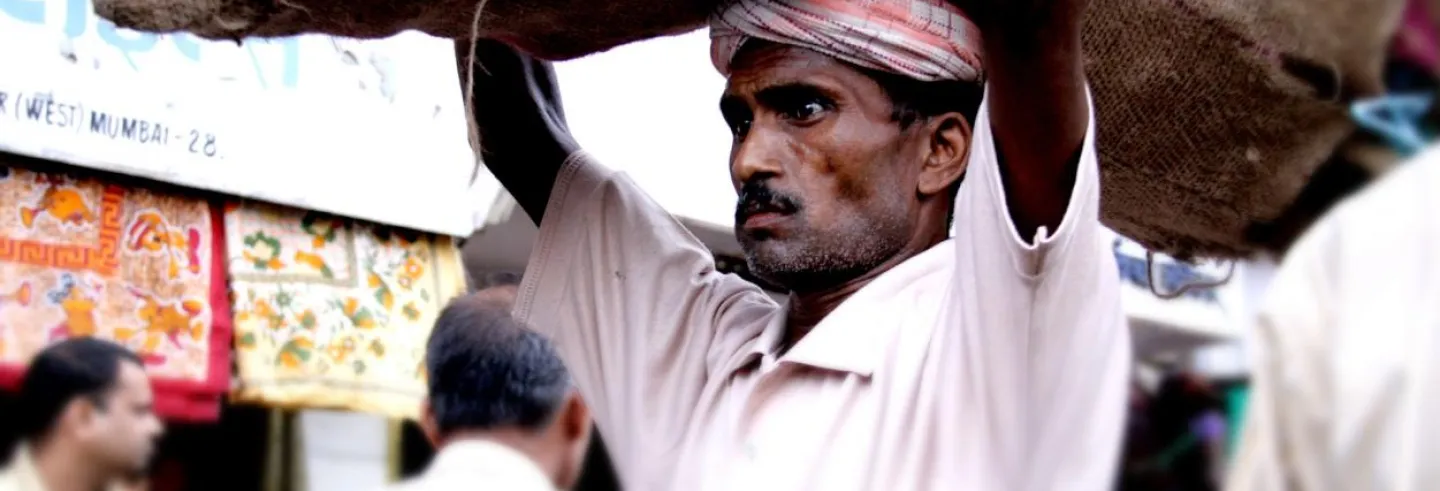It is a commonplace that our diagnosis of magnitudes and trends of phenomena such as poverty and inequality is very much a function of how we choose to measure these phenomena. This is why an important conceptual exercise that must precede the empirical exercise of actual estimation is the justification of one’s chosen approaches to measurement. This essay will first contend that some of the most frequently employed approaches to the assessment of deprivation are less than wholly convincing. These are then sought to be replaced by procedures which, though known, have not had the benefit of extensive acknowledgement and use. These procedures are then applied to the Indian context and it is demonstrated that our assessment of the problem of poverty is indeed a function of how we choose to measure it.
Specifically, the topic of enquiry in this article relates to what is frequently referred to as the “identification problem” in poverty measurement and how it is customarily dealt with by professional economists. As the term itself suggests, the identification problem is about how we identify the population that is supposed to be in poverty. This is usually done by specifying a level of income, or consumption expenditure, called the “poverty line,” below which an individual is deemed to be absolutely poor. It is claimed in this article that the standard procedures of identification are misleading. When we seek to correct these procedures in a certain “natural way,” it turns out—as we shall see later—that the procedures become redundant, that is, one would no longer find any real need for an income- or expenditure-based poverty line.
Money-metric poverty, or poverty measured on the basis of a money value of expenditure or income, can be shown to be perhaps more satisfactorily captured in an indicator such as the economist Kaushik Basu’s “quintile income statistic”1 than from poverty measures such as the more commonly used headcount ratio (the number of the poor as a proportion of the population), which are derived from a poverty line approach that we are more familiar with.
There is little that is original in this essay. If I nevertheless push an idea with something of a tiresome zealot’s persistence, it is because of a belief that professional economists must make some sort of sustained effort to (a) demystify their ideas; and (b) display a preparedness to be critical of their own tribe. In such a view of the matter, everybody has a stake in issues that are crucial to the well-being of a society and its economy. Non-professionals must not simply be left to the requirement of taking the professional’s judgement at face-value, without much in the way of elaboration, argument, or justification. In the process of such elaboration, it may be that the points I make are very straightforward and trivially true. If so, my defence must be that it is a lesser vice to be obviously right than to be obviously wrong.
With this explanatory preface out of the way, I shall now deal directly with the essay’s substantive concerns.
How Poverty is Measured in India
For professional economists, the “standard” method of measuring money-metric poverty—or let us just say income poverty—is to solve two problems, those of “identification” and “aggregation.” The first of these problems, to repeat what has been said, has to do with deciding on a level of income such that those falling below this level are certified as being absolutely impoverished. The second problem has to do with ways of combining information on the poverty line and on how incomes (or consumption expenditure) are shared in a population into a single real number which is intended to convey the number of poor that exists in society. In this essay, I shall deal largely only with the identification exercise.
...the poverty line, in practice, tends to be pitched very low. This is true, for instance, of both the World Bank’s “dollar-a-day” type poverty lines, and of India’s many official poverty lines which have been drawn up over the past quarter century.
What does one ordinarily understand by the term poverty line? The Oxford English Dictionary provides the following common-sense definition: the poverty line is “the estimated minimum level of income needed to secure the necessities of life.” Unfortunately, this ordinary-language understanding of the term frequently gives way to a self-referential, definition-discovering characterisation of the poverty line, of the type favoured by the Mirriam-Webster Dictionary, as “a level of personal or family income below which one is classified as poor according to governmental standards.” The result is that the poverty line, in practice, tends to be pitched very low. This is true, for instance, of both the World Bank’s “dollar-a-day” type poverty lines, and of India’s many official poverty lines which have been drawn up over the past quarter century. The most recent one, recommended by the Rangarajan Expert Group (Planning Commission 2014)2 has come up with the highest official poverty line for India, but it still falls far short of what, through ‘practical knowledge’ (in Marx’s words), we would all apprehend as the socially necessary means of subsistence. (See, for example, the attempt by Jayaraj and Subramanian to derive a poverty line for the state of Tamil Nadu3). There is therefore a problem of the appropriate use of language involved here.
It is obvious that the extent of poverty will rise as the poverty line rises. The headcount ratio, or proportion of the population in poverty, is the most widely employed numerical indicator of poverty. By pitching the poverty line low and without any proper deference to the notion of “adequacy,” we would succeed in projecting low magnitudes and—as it happens—come up with flattering trends in poverty rates. This is poverty-reduction through definition and manipulation: an exercise in self- and other-deception, and it serves no good scientific purpose nor ethical imperative.
It is instructive, in this context, to consider how the Indian official poverty line is fixed. (What is described here is a broad methodological approach which does not concern itself with differences in detail across the procedures adopted by various expert groups appointed by the Indian Planning Commission.) The Indian poverty line claims to be anchored in a “nutritional norm:” it is based on notions of what is a basic minimum of nutrition an individual must obtain every day in order not to be considered undernourished. Data from the National Sample Survey Office’s data on consumption expenditure are typically used to draw up this poverty line. We have in these surveys information on the consumption of the population (measured in money terms) in different expenditure classes (intervals of expenditure from low to high). We can obtain from the information on the food consumed in each of these classes, estimates of the calorie value of this food. These estimates can be employed to obtain a picture of calorie consumption that typically increases as consumption spending itself rises. The graph of calorie consumption as a function of consumption spending can be employed to read off the level of consumption expenditure per individual per day at which the nutritional norm is actually achieved.
Accounting for Consumer Choice
Thus, employing 1973–74 data on the distributions of calorie consumption and consumption expenditure, and employing a calorific norm of 2,400 kilocalories per person per day for rural India and one of 2,100 kilocalories per person per day in urban India, the 1993 Expert Group of the Planning Commission stipulated a poverty line of Rs 49.09 per person per month for rural India and one of Rs 56.56 per person per month for urban India, at 1973–74 prices. The consumption bundles (that is, baskets of different consumer goods and services) corresponding to these consumption expenditure levels can be identified, and the poverty lines for later (or earlier) years are obtained by simply revaluing these bundles at current prices.
Conventional economics tells us that consumers, in the light of their incomes and the prices facing them, do the best they can to arrive at their optimum consumption bundle. The official poverty line in India is derived from—in fact equated with—the value of the commodity bundle that corresponds to the calorific norm in 1973–74. In doing this, one is implicitly arguing that there is something sacred about the pattern of consumption expenditure favoured by the “representative consumer” in 1973–74. Why this special normative status for the year 1973-74? The underlying presumption strikes one, on reflection, as being nothing short of bizarre! If consumers, instead, are seen as maximising utility in every year, and not only in 1973–74, then a consistent way of fixing the poverty line in any year would be to read off the level of consumption expenditure at which the nutritional norm is realised in that year. This is precisely what the economist Utsa Patnaik4 recommends. However, there is nothing to commend what Sanjay Reddy5 has described as these sorts of wholly “inductive” procedures. But from the profoundly philosophical consideration that what is sauce for the goose is sauce for the gander, Patnaik is right if the official procedure is right, and the official procedure is suspect if Patnaik’s findings are suspect.
The problem is that the official procedure displays a nicely flattering trend of declining poverty rates, while Patnaik’s procedure displays a rising trend of poverty! The official procedure refuses to allow for any changes in the relative prices of commodities (for example, for the possibility that food items may register larger rates of price-increase than non-food items); it refuses to allow for “taste” changes (with, for example, preference for non-food items of consumption such as health, education and transport becoming more salient with the process of development); and it refuses to allow for changes in the status of goods (such as firewood for fuel) from common-property resources to marketised commodities. By refusing to allow for such changes, the official identification procedure also allows for a disturbing corollary fact. This is that as one moves forward in time, the calorie consumption at the official poverty line falls further and further short of the original nutritional norms in which the poverty line was grounded. This is the so-called “calorie-drift” that has been observed by several commentators.
Finding the Right ‘Yard Stick’
At the heart of these difficulties is the basic requirement of consistency in all measurement exercises. This is the requirement that the norm of measurement must be invariant in all contexts where the relevant measurement exercise is undertaken. What does one mean by this? Here is an example to illustrate the proposition. If the length of this blackboard is measured by a foot-rule, so must the length of that blackboard. That is to say, the appropriate norm of measurement here is the “yard-stick,” which means that one must preserve invariance of the measurement norm in the space of “length.” It would not make much sense to, instead, preserve invariance of the norm in the space, say, of “weight.” Thus, in the example under consideration, if wood is twice as heavy as plastic, then by preserving invariance of the norm in the space of weight, we would be doing the insensible thing of measuring the length of this blackboard with a foot-rule, and the length of that blackboard with a double-foot-rule, with the foot-rule serving as the standard unit of length for this blackboard, and the double-foot-rule as the standard unit of length for that blackboard!
And so with poverty standards. In what space must we preserve invariance of the poverty norm when we are measuring that phenomenon? Amartya Sen6 has pointed out that poverty must be specified in an absolute way in the space of what he calls “human functionings.” Functionings are alternative states of “being” and “doing.” A functioning is a description of a person’s condition or activity with respect to some chosen dimension of “being” or “doing.” Thus, if the functioning in question relates to a person’s “nutritional status,” then to say that the person is “well-nourished” is a particular description of her state of being with respect to her nutritional status. If the functioning in question relates to her “health status,” then to say that she is “prone to enteric disease” is a particular description of her state of being with respect to her health status. If the functioning in question relates to her “mobility status,” then to say that she is mobile is a particular description of her state of doing with respect to her mobility status. And so on, in relation to other aspects of the person’s functioning, such as her “knowledge status,” her “shelter status,” or her “clothing status.” The examples can be easily multiplied.
Inaccurate Measures
What does it mean to say that poverty must be specified in an absolute way in the space of functionings? Suppose, for specificity, that the functioning is nutritional status. Then, we specify poverty in an absolute way when we simply say that avoiding nutritional deprivation requires a person to be well-nourished. This may require us to specify, in the space of resources, that the person should have adequate calorie intake in order to be judged to be free of nutritional deprivation. But notice that when we do that, we must allow for the possibility that “adequate calories” may mean different things to different people. For instance, if you are a pregnant and lactating woman and I am not, then you will require more calories and I will require less calories in the space of resources in order to achieve the same status of being well-nourished, a requirement that is specified absolutely in exactly the same way for both of us in the space of functionings.
Consider another example. You may live in a cold country and I in a tropical country. While we may specify, in functionings space, the requirement of being “adequately protected against the inclemencies of the weather” in order to escape deprivation with respect to the functioning of “protection against the weather,” in resources space this may require that you possess more warm clothing than I. Therefore, for reasons of individual heterogeneity, or for reasons of contextual/environmental variations in the circumstances of individuals, one must expect that there will be interpersonal variations in the ability to convert resources into functionings. Arising from this, we can have variations in the amount of resources needed to achieve a given level of satisfactory human functioning. This is what accounts for Sen’s suggestion that poverty should be seen as an absolute concept in the space of human functionings, but as a relative conception in the space of commodity bundles, or “real incomes,” or “resources” in general.
What does any of this have to do with the “identification problem” in the measurement of poverty? A great deal. Economists typically solve the identification problem by specifying the poverty line in the space of resources. This could be a given level of “real” income (that is, money income adjusted only for price variations). Or it could be a particular, unvarying commodity bundle (as in the case of India’s official poverty estimates). Or it could be some norm of calorific intake (from which, as it happens, the corresponding commodity bundle is derived in India’s official procedures, along lines we have described earlier). The point is that when we specify some unique poverty standard in the space of resources, we do violence to the sensible notion that the norm ought to be specified absolutely in the space of functionings and—because of individual differences in the capacity to convert resources into functionings—in an interpersonally or inter-contextually relative or variable way in the space of resources. This problem is an acute one, and accounts for the sort of widely differing estimates of poverty which we have seen are thrown up by official methods, on the one hand, and the method resorted to by economists such as Utsa Patnaik, on the other. Briefly, the identification problem, in much of mainstream practice, tends to preserve invariance of the poverty norm in the space of resources rather than of human functionings. There is therefore a problem of logic involved here.
...when we seek to correct the [conventional] procedures [of identification] in a certain “natural way”, it turns out…that the procedures become redundant, that is, one would no longer find any real need for an income- or expenditure-based poverty line.
Alternative Measures
Why not, then, specify the poverty line in terms of the pecuniary costs that would be entailed in achieving certain basic, satisfactory levels of human functionings in the matter, say, of nutrition, clothing, shelter, knowledge-attainment, and health status? This could result in different poverty lines for different persons, depending on each person’s rate of conversion of resources into functionings. This, in turn, would imply a massive practical problem of estimating, justifying, and collating myriads of poverty lines in income space. Apart from this forbidding practical difficulty, we also have a conceptual problem to deal with here. When income poverty lines are specified by adding up the “pecuniary costs of achieving certain basic, satisfactory levels of human functionings,” we are begging a rather elementary logical question. The question is: why not measure deprivation directly in the space of human functionings, by resorting to a number of so-called multidimensional measures of poverty which many economists have already advanced?7 Why rely on the roundabout way of converting functioning requirements into income requirements in order to measure poverty? This is precisely the difficulty that was alluded to in the introductory section of this article, where it is stated that “when we seek to correct the [conventional] procedures [of identification] in a certain “natural way”, it turns out…that the procedures become redundant, that is, one would no longer find any real need for an income- or expenditure-based poverty line.”
Reasonable Simplicity
When we speak of income poverty per se, there seems, therefore, to be a case for viewing income not as a means to an end, but as an end in itself, that is, to see the attainment of command over some satisfactory level of income as a desired human functioning, in and of itself. If we wish to speak of poverty lines without risking an abuse of language, then we must see income as a means (for achieving the end of some level of satisfactory human functioning), and this will entail avoiding the logical lapse of seeking invariance of the poverty line in the space of resources rather than functionings. This, in turn, will beg the question of why we should not, instead, measure poverty directly in the space of human functionings with the help of multidimensional measures of deprivation. The problem would not arise if we thought of money-metric poverty as a matter of avoiding low incomes, as such.
Philosophers use the term simpliciter to signify that which is simple, or straightforward, or means just what it says, or is absolute and unconditional. Much of the preceding discussion amounts to no more than a plea for the use of an income poverty indicator simpliciter. Such a poverty indicator is what Kaushik Basu has called the “quintile income statistic” (or Q, for short). Q is just the average income of the income-poorest 20% of any population. The lower the value of Q, the greater—in some straightforward sense—is the extent of income poverty. The idea here is that when we speak of money-metric or income poverty, we focus directly on the income levels of the income-poorest sections of a population. There is no implication here that income is the only welfare indicator that matters; the implication is, though, that it is wholly appropriate to concentrate on income, as such, when what we are speaking of, after all, is “income poverty”! Any two levels of quintile income can be compared with each other in terms of the “greater than,” “equal to” or “less than” criterion, which makes poverty rankings in terms of Q an elementary matter. “Absolute” lowness of the quintile income can also be assessed by comparison of Q with a “broadly reasonable” income poverty line such as would be suggested by “practical knowledge” and “common sense.” Exacting precision in stipulating the poverty line is not a requirement here, unlike in the “identification-cum-aggregation” route to poverty measurement where, for example, getting the poverty line off by a couple of rupees might mean including or excluding a couple of million persons in poverty!
One way of tracking the performance of the quintile income statistic is to see how it compares with some rough assessment of the poverty line as it is understood by the Oxford English Dictionary. The average per capita monthly consumption expenditure level of the poorest 20% of India’s rural (respectively, urban) population in 2011–12 was Rs 584 (respectively, Rs 842) in current prices. The Rangarajan Expert Group proposed rural and urban poverty lines of Rs 972 and Rs 1407 per person per month. Q, as a proportion of the poverty line, is 60% for rural India, and 69% for urban India. This is, quite simply, a shocking statement on the living standards of some 240 million human beings (which is 20% of the 2011 all-India population), when we consider that the official poverty lines themselves bear little relation to any meaningful notion of adequacy.
An Illustration
Further, let us consider some simple computations that can be made from data on consumption expenditure in the National Sample Surveys of 1993–94, 2004–05, 2009–10 and 2011–12. Let us propose a modest “desired” rate of growth of 3% (compound) per year for the quintile income in 1987–88. (It is a major national pastime to compare actual with desired rates of growth of average per capita national income, so why not an occasional indulgence toward the average income of the poorest 20% of the population?) Then the desired 2004–05 quintile income is the actual 1993–94 quintile income compounded at 3% per year over 11 years; the desired 2009–10 quintile income is the actual 1993–94 quintile income compounded at 3% per year over 16 years; and so on. If the ratio of the desired–to–actual Q is a quantity that displays an over-time declining trend of less than one, then that is a good sign for money-metric poverty.
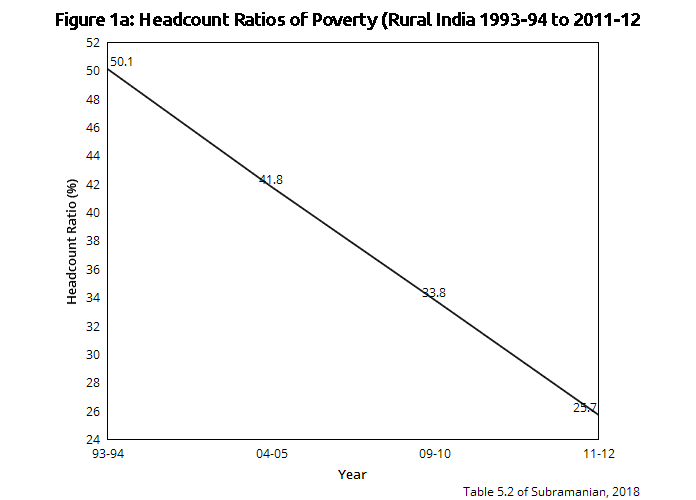
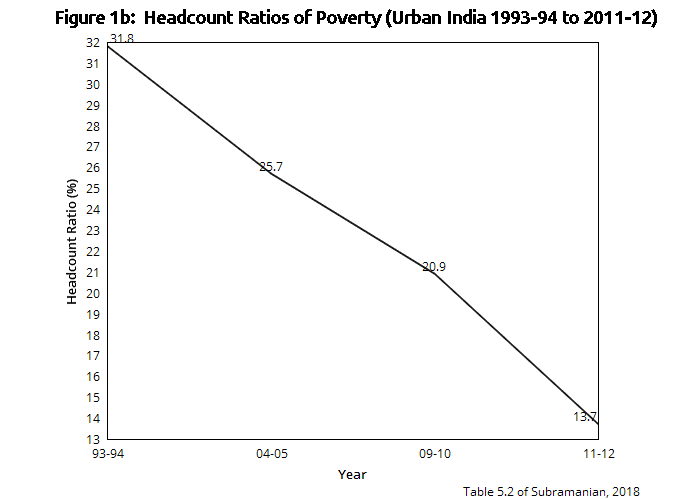
Figures 1a, 1b, 1c and 1d8 provide the trends in both the headcount ratio of poverty for the official Tendulkar poverty lines, and the desired–to–actual quintile income ratios, separately for rural and urban India, over the years 1993–94, 2004–05, 2009–10 and 2011–12. The trend is a prettily declining one for the headcount ratio, and a not so prettily increasing one for the desired-to-actual quintile income ratio. Our diagnosis of what is happening to poverty is unmistakably a function of how we choose to measure it.
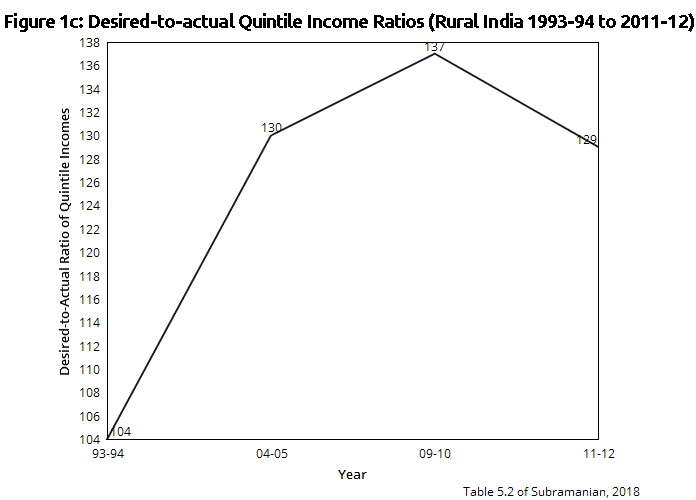
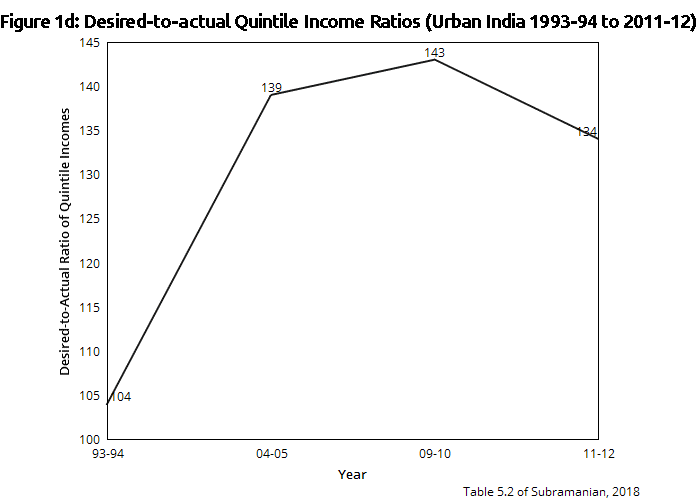
My contention is that one way of measuring money-metric poverty which I have argued to be more persuasive than official procedures in this regard, suggests, at the least, two propositions that tend to get lost in the euphoria generated by official statistics: (a) that the decline in poverty is nowhere as dramatic as we have been led to believe is the case; and (b) that there is still a very great deal of harsh and unyielding money-metric poverty in the country.
Above All Else, Be Humane
In concluding this essay on the subject of the measurement of deprivation, one would like, finally, to allow oneself the luxury of abandoning the distant style of the dispassionate scientist in favour of a more human engagement with the subject. For, as Albert Camus9 put it: “In a subject at once so humble and also heavy with emotion, the learned and classical dialectic must yield, one can see, to a more modest attitude of mind.” In this spirit, attention is invited to the following passage, which might well be a contemporaneous description of aspects of poverty and inequality in India today:
[W]hat sort of justice do you call this? People…who…do no work at all…are rewarded…by a splendid life…But [those]…who never stop working like cart-horses, at jobs so essential that, if they did stop working, they’d bring any country to a standstill within twelve months – what happens to them? They get so little to eat, and have such a wretched time, that they’d almost be better off if they were cart-horses. Then at least, they wouldn’t work quite such long hours, their food wouldn’t be very much worse, they’d enjoy it more, and they’d have no fears for the future. As it is, they’re not only ground down by unrewarding toil in the present, but also worried to death by the prospect of a poverty-stricken old age – since their daily wages aren’t enough to support them for one day, let alone leave anything over to be saved up when they’re old…What’s more, the wretched earnings of the poor are daily whittled away by the rich, not only through private dishonesty, but through public legislation. As if it weren’t unjust enough already that the man who contributes most to society should get the least in return, they make it even worse, and then arrange for injustice to be legally described as justice.As it happens, this is an account of the world around him as he saw it in 1516, by Thomas More in his book Utopia.10 If this description of reality does us little credit, it does us—notably those among us whom Edmund Burke called “sophisters, economists and calculators”—it does us even less credit that we should try and evade that reality by mis-measuring our way out of the ugly truth.

